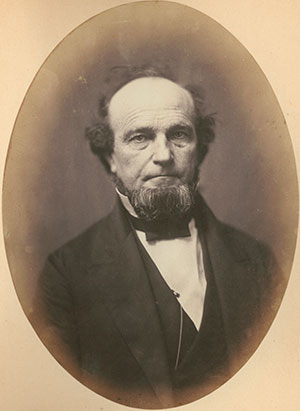
Photo: Morgan L. Martin (1805-1887), Wisconsin lawyer, judge, politician, land speculator, and one of the leading figures in early Wisconsin history. Martin settled in Green Bay in 1827 on the advice of his cousin, James Duane Doty. During his career he was elected to many political offices; this portrait probably dates from his 1858-1859 term in the state senate. In addition, Martin was the chief promoter of various Fox-Wisconsin River improvement projects, and was an early developer of Milwaukee. Wisconsin Historical Society, Fuller, John S., ca. 1815-1902 (creator), Morgan L. Martin (title), Image 38131, viewed online at www.wisconsinhistory.org/Records/Image/IM38131. Reprinted with Permission.
In 1846, Wisconsin’s territorial government launched its next legal step toward statehood – pursuing a Congressional Enabling Act. Passage of such an act was necessary to green-light a constitutional convention in the territory.1 For its first 49 years, the area that would become Wisconsin was subject first to the strictures of the Northwest Ordinance of 1787 (13 years, 1787-1800) and then to governance under the laws of successive territories (36 years),2 until this amorphous “western territory” obtained Wisconsin Territory status in 1836.
The Wisconsin territorial government executed its duties for a decade, not pursuing statehood because of a mix of political and economic reasons. However, as the boundaries of contiguous territories seeking statehood impinged on the Wisconsin Territory’s claims, the legislature voted on a resolution for action. Governor Henry Dodge communicated the resolution to the 28th Congress, asserting that the U.S. government had allocated parts of the Wisconsin Territory to the states of Illinois and Indiana and had “invaded” parts of Wisconsin when proposing boundaries for the soon-to-be-admitted state of Michigan.3 When the question was put to the enfranchised inhabitants of Wisconsin, they voted for an Enabling Act as the preliminary step to state admission.4
Mr. Martin Goes to Washington
Armed with the will of the voters to pursue passage of the Enabling Act, the Wisconsin Territory’s congressional delegate, Morgan L. Martin, a lawyer, traveled from Green Bay to Washington, D.C., to campaign for Congress to pass an Enabling Act. Such an act was one of the innovations in the Northwest Ordinance. Passage of the Act gave the territory the parameters and permission to convene a constitutional convention, to adopt a voter-approved state constitution, and to define the boundaries of the proposed state – all these steps were to occur pending admission as a state.
On Jan. 9, 1846, Martin submitted notice to Congress of his intent to introduce the enacting bill, which he presented to the House Chamber on Jan. 14, 1846. He shepherded the bill from start to finish: introduction to the House’s Committee on Territories during May, referral to the House and its approval in early June, introduction in the Senate on June 11 and referral to the Senate’s Committee on Territories, the positive Committee report to the Senate on July 9, passage in the Senate (without debate or division) on Aug. 6, and signing by President James K. Polk on the same day. Among the Congressmen who considered and voted on the Enabling Act were John Quincy Adams, Jefferson Davis, Stephen Douglas, Andrew Johnson, and Hannibal Hamlin.
After years of delay in the next step to statehood, the territory’s Enabling Act passed with unexpected celerity. Despite soliciting a tremendously preoccupied Congress, Martin achieved bill passage within eight months. During the demanding 1845-47 session, members of Congress struggled with a banking debate and a monetary crisis, the politics over the country’s internal improvements, the admission of states, California’s declaration of independence from Mexico, the potential expansion of slavery in the southwest, President Polk’s intent to enforce the Monroe Doctrine and his plans for aggressive westward expansion, and, most notably, the declaration of war against Mexico and the extensively debated funding for the war.5
Bold Strategy Almost Sunk the Bill
For Martin to garner the attention and votes of Congress in the throes of such historic events and distractions was remarkable. And yet he almost failed to get the Enabling Act passed. He had carved a seemingly innocuous phrase from the original bill, a strategic amendment that proved to be a bridge too far.
 Hannah C. Dugan, U.W. 1987, is a Milwaukee County Circuit Court judge. She is a Fellow of the Wisconsin Law Foundation.
Hannah C. Dugan, U.W. 1987, is a Milwaukee County Circuit Court judge. She is a Fellow of the Wisconsin Law Foundation.
Before the House vote in June, Martin obtained the unanimous consent of the body to amend the bill by striking this phrase: “That the state doth consent to and accept the boundaries in the act prescribed.” The amendment in effect provided that the territorial residents would decide the state’s boundaries at the state’s constitutional convention. Wisconsin residents could vote to expand the state’s control over an additional area of 12,000-15,000 square miles or possibly secure up to an additional 68,000-square-mile area – more than doubling Wisconsin’s current land area.6 Indeed the amendment proved so stealth that the House passed the bill as amended unaware of the substantial “land grant” within it.
Within days, a Connecticut representative realized the implications of the amendment and raised the issue of the “smuggle” (as he put it) on the House floor. He called out Martin regarding his motives and tactics; he then moved for reconsideration of the House’s vote. Debate continued until a vote on the motion for reconsideration was taken; it passed, on a vote of 125 in favor and 45 against.
Despite some high-risk parliamentary moves, Martin had to sacrifice the smaller point to prevail on the task at hand: securing the Enabling Act.
Resource Information
Arthur J. Dodge, Wisconsin’s Admission as a State: The History of the Enabling and Admission Acts in the XXIXth and XXXth Congresses (the Milwaukee Sentinel & the St. Paul Pioneer Press 1898).
Library of Congress, Primary Documents in American History: Northwest Ordinance, https://www.loc.gov/rr/program//bib/ourdocs/northwest.html (last visited June 5, 2023).
LOC’s Public Domain Archive, Some Legacies of the Ordinance of 1787, https://loc.getarchive.net/media/some-legacies-of-the-ordinance-of-1787-5b8464 (last visited June 5, 2023).
Mark Wyman, The Wisconsin Frontier (Bloomington: Indiana Univ. Press, circa 1998).
Alice E. Smith, The History of Wisconsin: From Exploration to Statehood, Volume 2 (Madison, State Historical Society of Wisconsin, 1973).
Milo M. Quaife, The Attainment of Statehood (Madison, State Historical Society of Wisconsin, 1928).
United States. Congress. The Congressional Globe, Volume 2-3: Twenty-Fourth Congress, First Session, book, 1836; Washington D.C. (accessed May 26, 2023), University of North Texas Libraries, UNT Digital Library, https://digital.library.unt.edu/ark:/67531/metadc30905/m1/615/.
United States. Congress. The Congressional Globe, Volume 3-4: Twenty-Eighth Congress, Second Session, book, 1845; Washington D.C. (accessed May 26, 2023), University of North Texas Libraries, UNT Digital Library, https://digital.library.unt.edu/ark:/67531/metapth2366/m1/30/.
United States. Congress. The Congressional Globe, Volume 2-3: Twenty-Ninth Congress, First Session, book, 1846; Washington D.C. (accessed May 26, 2023), University of North Texas Libraries, UNT Digital Library, https://digital.library.unt.edu/ark:/67531/metadc30905/.
Laws of Wiskonsan Territory Passed by the Fourth Legislative Assembly. Madison, Wisconsin: Wisconsin Territory. 1844. Retrieved May 30, 2023, https://books.google.com/books/about/Laws_of_Wiskonsan_Territory.html?hl=ms&id=mT1iAAAAMAAJ.
Endnotes
1 The creation of the 30th state rests on six legal pillars: an ordinance, a territorial petition, a voter-approved statehood referendum, an Enabling Act, a voter-approved constitution, and Congressional ratification for admission. The first article in this series discussed the Northwest Ordinance of 1787, the petition establishing the Wisconsin Territory, and the referendum authorizing the initiation of the process for Wisconsin Statehood; see Hannah C. Dugan, Part 1 – From Territory to Statehood: The Creation of Wisconsin, 96 Wis. Law. 39-41 (June 2023).
2 “Wisconsin” was subject to the respective laws of the Indiana Territory until 1800, the Illinois Territory until 1809, and the Michigan Territory beginning in 1818.
3 “The Toledo War” was fought between Ohio and the Michigan Territory a decade earlier. Through a compromise, the disputed claims were resolved by ceding to Michigan the area that is now the Upper Peninsula and ceding to Ohio the area including and surrounding Toledo. Similarly, Illinois was concerned that the carve out of what is now Wisconsin might create a state so large as to be disproportionate to other states’ sizes. To resolve that concern, Congress approved a boundary along northern Illinois. Without the boundary adjustment, Wisconsin would have a significant swath of present-day Illinois, including Chicago, and Illinois would have been left without a Great Lakes port.
4 Wisconsin Territory voters previously failed to pass statehood referenda three times – in 1842, 1843, and 1845. The only persons with suffrage for each of the referenda were white males who were at least 21 years old.
5 For example, Congress debated and declared war on Mexico on May 12; on May 14, the Enabling Act was reported out of the Senate Committee on Territories while Congress debated and passed funding for the war.
6 Martin’s proposal was not without merit. The Ordinance dictated that 3-5 states would be formed out of the western territories. As the fifth and final state to be admitted under the Ordinance, Wisconsin essentially sought to claim the residual area of the western territories not yet included within the boundaries of any of the five states. The swath of land in dispute was northwest of the 1836 Wisconsin Territorial boundaries. The disputed area is now within Minnesota’s boundaries.
» Cite this article: 96 Wis. Law. 49-51 (July/August 2023).
